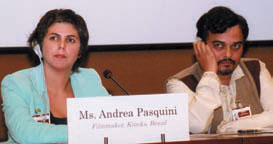|
Documenting Leprosy's Human Face
Filmmakers examine the leprosy experience in Brazil and India.
When Brazilian filmmaker Andrea Pasquini went in search of a location for a fictional movie she was planning to make on the “deplorable state” of public hospitals in Brazil, she encountered something even more shocking: Santo Angelo, one of Brazil's 33 colony hospitals for persons affected by leprosy and home to several people for over 60 years.
“I had no idea places like that existed in Brazil, and that Brazil was at the top of the list [sic] of countries with the most cases of leprosy,” she told a workshop on the sidelines of the 57th session of the UN human rights Sub-Commission in Geneva.
She immediately remembered her childhood in Casa Branco, a small town in the interior of the state of Sao Paolo, where terrifying stories involving “lepers” were commonly told.
“My grandmother, to whom my film is dedicated, used to warn me that, if ever I met a group of people dressed in rags and asking for food, I should run away as fast as possible, because those people had a highly contagious disease that would cripple anyone who they had contact with.
“My grandmother is one of the most generous people I have ever known. However, a lack of information made her the bearer of terrible prejudice. Like her, millions of people around the world continue to disseminate completely unfounded ideas about this disease.”
The Best Years of Our Lives was Pasquini's way of fighting against the frightening images of leprosy that filled her childhood by showing “the dignity, the everyday life, the dreams and achievements” of those touched by the disease.
The film, which won first prize at the prestigious It's All True documentary film festival in 2003, consists of testimonies from the remaining residents of Santo Angelo, recalling the days when hospitalization of those affected by leprosy was compulsory. It's a tale of aching sadness and despair, but also of the triumph of the human spirit in the face of adversity.
“Meeting the people portrayed in the movie was one of the best gifts I have received in my entire life,” said Pasquini. “Despite all the suffering engraved in their memories and in their bodies, the wish to live a full life led those people to weave personal stories full of emotion, conquest, faith, love, creation, courage and humility.”

|
Pasquini (left) and Chowdhury take questions in Geneva.
|
MEDIA INDIFFERENCE
Like Pasquini, Indian journalist Ujjwal K. Chowdhury grew up with the notion that leprosy-affected persons were beggars. “I never considered that ‘leper’ was a derogatory term to identify a particular community as distinct and inferior from the rest of the community ― even as a working journalist,” he told the workshop.
Indeed, the Indian media have largely been indifferent to this issue, he said, “and even where there have been stories, they have been misleading stories, which have served to reinforce prejudice.”
It was exposure to the work of the International Leprosy Union and the activities of the Goodwill Ambassador for the Elimination of Leprosy that opened Chowdhury's eyes. “When I saw Mr. Sasakawa embracing people affected by leprosy in the dingy lanes of Kolkata, I was astounded, because I had never done that in all my 38 years,” he said. “I realized that the image we had [of persons affected by leprosy] was totally wrong with respect to their treatment, rehabilitation and rightful position in society, which is how I and my team became involved in the movement for the regaining of dignity.
The resulting documentary ― Leprosy, Stigma, Suffering ― What Next? ― depicts the exclusion from Indian society of those affected by the disease and the denial of their basic civil rights. A follow-up film From Dignity Lost to Dignity Regained* covers their struggle for social acceptance and rehabilitation. A related book, Dignity Regained, is a compilation of inspiring stories of 12 men and women who overcame stigma and prejudice to find personal and professional fulfillment.
“Leprosy is the story of 11 million Indians,” said Chowdhury, pointing out that more than 1% of India's population has the disease or has been treated for it. It was a story he himself only recently took note of, but one he now wants everyone to hear.
Cover of Dignity Regained (top),
flyer for The Best Years of Our Lives
Reference
* From Dignity Lost to Dignity Regained will be shown on Indian television in January 2006.
|